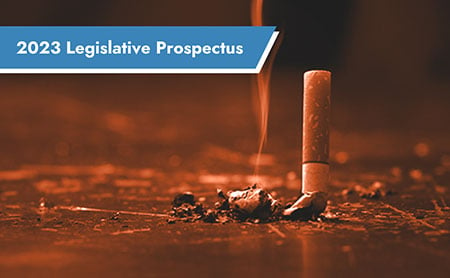Tobacco and Nicotine Products: An Enduring Epidemic
December 12, 2022
Introduction
 According to CDC, tobacco use is the leading cause of preventable disease, disability, and death in the United States. Today, there are indications that cigarette smoking is declining, while the use of diverse nicotine products is gaining popularity among younger users.
According to CDC, tobacco use is the leading cause of preventable disease, disability, and death in the United States. Today, there are indications that cigarette smoking is declining, while the use of diverse nicotine products is gaining popularity among younger users.
Nicotine is a highly addictive chemical compound found in tobacco products, electronic cigarettes (e-cigarettes), smokeless tobacco, and other nicotine products (e.g., nicotine pouches). Most e-cigarettes contain nicotine, which is harmful to adolescent brain development, a health danger for pregnant people, and toxic to fetuses. E-cigarette aerosol can also contain cancer-causing chemicals, heavy metals (e.g., lead), and volatile organic compounds. Evidence shows that even e-cigarettes without nicotine are harmful to the lungs. It is worth noting that many manufacturers of e-cigarettes and other nicotine products have been using synthetic nicotine, or nicotine that is not derived from tobacco leaves.
Legislative Trends
Flavored Products
In 2020, FDA released its guidance of enforcement priorities for e-cigarette products that appealed to youth. In 2022, Congress enacted a law authorizing FDA to regulate products containing synthetic nicotine, closing a loophole that had allowed e-cigarette manufacturers to market synthetic nicotine products as “tobacco-free” and avoid regulatory rules prohibiting fruit and menthol flavors. (Including cooling flavors in e-cigarettes is associated with significantly higher sales.) Additionally, of the more than 2.5 million high school and middle school students currently using e-cigarettes, nearly 85% use flavored tobacco or nicotine products.
Initially signed into law in August 2020 and upheld by voters in the November 2022 general election, the California State Legislature passed the Proposition 31 referendum prohibiting the sale of flavored tobacco products. In doing so, California joined Massachusetts as the only two states with comprehensive flavored tobacco product restrictions. In 2022, at least 13 other states (Colorado, Connecticut, Hawaii, Illinois, Indiana, Maine, Minnesota, Nebraska, New Jersey, New York, Rhode Island, South Carolina, and Washington) considered legislation restricting or banning flavored tobacco or nicotine products. Although Hawaii’s legislature passed a bill banning flavored e-cigarettes, the governor vetoed the bill, citing a late amendment that would make it more difficult for the health department to enforce the proposed ban.
Price Changes
Increasing prices on e-cigarettes and nicotine products is a fact-based method of reducing overall tobacco use. States can apply a percentage price increase based on the sale price, price e-cigarette and nicotine products at the same rates as combustible cigarettes, and impose a per milliliter price increase on liquid nicotine or consumable material. In 2022, twenty states considered legislation concerning price increases for tobacco or nicotine products. Of those, two state legislatures (Alaska and Virginia) passed bills to increase the price of certain tobacco products. Alaska’s governor vetoed the legislation due to concerns about increasing taxes on residents. Virginia’s new law creates a tax on remote tobacco sales and authorizes remote tobacco retailers.
Smoke-Free Environment and Preemption
Clean air and a smoke-free environment are essential to reducing negative health outcomes such as heart disease, lung cancer, and an increased risk of stroke. Each year, secondhand smoke causes more than 7,300 lung cancer deaths for adults who do not smoke. In 2022, at least eleven states (Florida, Idaho, Kentucky, Massachusetts, Mississippi, New Jersey, New York, Nebraska, Oklahoma, Tennessee, and Wisconsin) considered legislation related to smoke-free environments or limiting local control over tobacco or nicotine products (i.e., preemption) for tobacco or nicotine products. Three states—Florida, Oklahoma, and Tennessee—enacted smoke-free environment laws. Florida’s new law allows counties and municipalities to further restrict smoking, with the exception of unfiltered cigars, within the boundaries of public beaches and parks. Idaho’s new law prevents local units of government from adopting or enforcing requirements more restrictive than state law pertaining to regulating, marketing, or selling tobacco products or electronic smoking devices.
Looking Ahead
ASTHO expects states and territories to continue to adopting laws and policies aimed at reducing youth access to tobacco and nicotine products. In addition to laws related to flavored products, price increases, smoke-free environments, and preemption, states and territories may consider actions to:
- Broaden the definition for tobacco and non-tobacco products to include synthetic nicotine.
- Enhance enforcement of existing laws that prohibit selling tobacco products to individuals under 21.
- Raise the state or territorial minimum age of sale for tobacco products to 21.
- Establish state maximum nicotine levels for tobacco.